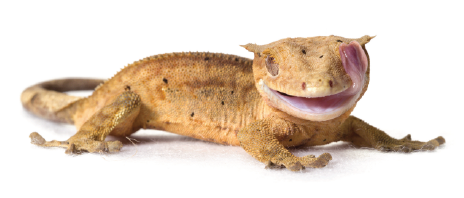 |
| Printable Version: Fluker's Crested Gecko Care Sheet and Product List (PDF) |
Download |
| Video Tutorial: Fluker's Crested Gecko Setup & Care Tips with Dr. Mark Mitchell (YouTube) |
Watch Now |
Crested Gecko Habitat Setup and Care |
|
Crested geckos are friendly, easy to handle, and inexpensive to care for, making them great pets for families and first-time lizard owners. But it’s important to do your research before bringing your new pet home. Be sure to have all supplies ahead of time, such as housing, accessories, and food. This will help ensure your new crested gecko has an easy and healthy transition period into your care. Quick Facts● These unique-looking geckos come in a variety of beautiful colors and patterns. ● They are often called “Eyelash Geckos” for the fringed projections that run from the top of their eyes and down their necks and backs. ● The average adult ranges 5-8 inches in length, tail included. ● They were once thought to be extinct until they were rediscovered in 1994. |
EnclosureCrested geckos are arboreal, or tree-dwellers, so you’ll need a tank with some vertical space for climbing. If you’re starting with a baby gecko, select a glass or plastic 10-gallon vertical tank with a screen lid. You’ll need to move to a 20-gallon tank or larger as your gecko grows. |
SubstrateTo help maintain humidity, choose a substrate that retains moisture such as coconut fiber bedding, moss, or bark. Dampened paper towels are recommended for baby geckos as they are more likely to accidentally swallow other substrates. |
AccessoriesCresties love to climb and need places to hide and feel safe. Add a variety of plants, branches, vines, and bark for your pet to climb on and hide under. Live plants are best because they will help regulate humidity inside the terrarium, but artificial plants will do. Do not over clutter the tank; leave plenty of open space. |
Temperature & LightingCrested geckos come from warm subtropical climates. Daytime temperature should be kept around 75-80° F, and night temperature should be between 68-75° F. If needed, radiant heat with a low wattage heat source is recommended. Cresties are nocturnal, so they do not need special UV lighting. However, a red nighttime bulb allows for viewing when they are active at night while also providing some heat. Crested geckos thrive when the humidity is between 50% and 70%. To maintain humidity, mist the terrarium once or twice per day with a spray bottle of water or place a cool mist humidifier nearby. Monitor the humidity and temperature inside your enclosure with a digital thermometer/hygrometer. |
Diet & NutritionCrested geckos are omnivores; their diet consists of insects and fruits. A commercial powdered diet is usually well accepted and is the easiest way to ensure a well-balanced, nutritious diet. Juveniles should be fed daily, but adults can skip several days between feedings. We recommend supplementing a commercial diet with live crickets (or other prey insects) 1-2 times a week. Insects should be “gut-loaded” with a high-quality diet for at least 24 hours prior to being offered. This enhances their nutritional value substantially. Provide a shallow dish of water at all times and put a large rock in the bowl so any crickets that accidentally get in the water can escape. Fluker's provides helpful tips and tricks to follow when trying to supplement live diets with freeze-dried or commercial dry diet foods. |
Handling & SafetyNewly purchased crested geckos should not be handled for the first 2-3 weeks to let them adjust to their new environment. They have fairly docile temperaments and seldom bite, though they can be a bit skittish and care is required when handling. Cresties may drop their tails if handled roughly or to attempt to get away, but unlike other geckos, they will not regenerate their tails. You can keep one male and several female crested geckos together. Males may fight, particularly when in the company of females, and should not be kept together. Cresties have specialized toe pads that allow them to effortlessly move along vertical surfaces. They are also good jumpers. They shed regularly; do not be surprised to see them eating their shedding skin! |
